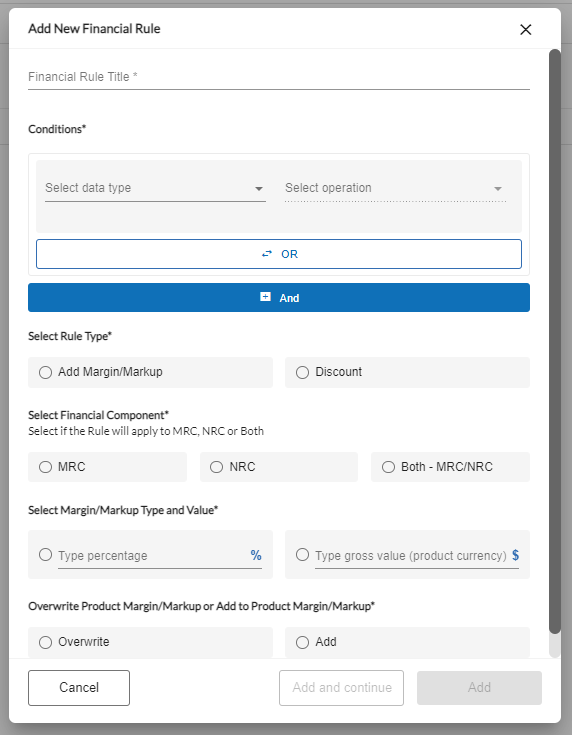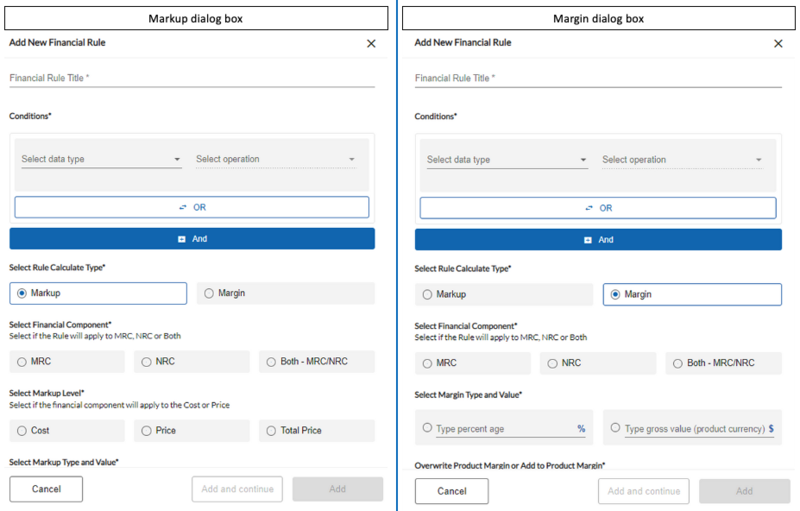Configure Financial Rules and Discounts
About Financial Rules
Financial Rules is a user level entitlement that enables you to configure complex rules, with AND/OR functions, around costs and prices. It supports various conditions, such as Access Medium, Account Name, etc. It allows you to update MRC, NRC, or both, and can be modified at Cost, Price, or Total Price, by percentage or number (dollars).
Financial Rules enables you to define certain conditions in which to apply pricing rules. Each rule is limited to 20 conditions.
To configure financial rules to update cost, price, and/or total price:
Click from the navigation sidebar.
Click .
Result: The Financial Rules page displays. If rules have previously been configured, they are listed here. Otherwise, the page is blank.
Click Add New Rule.
Result: The Add New Rule dialog box displays.

Note
All * fields are required fields, i.e., Conditions are required.
In the Financial Rule Title field, give the rule a unique name for easy identification.
In the Conditions section, use the drop down list in the Select data type field to select the data type options. The limit is 20 conditions per rule.
Condition
Description
Access Medium
Access medium types included in the price quote. The medium used for connectivity to the building or specified location.
Range of valid values:
Coax/HFC
Copper
Fiber
Wireless – Fixed
Wireless – Mobile
Wireless – Satellite
Other
Account Name
The name given to identify the CPQ Account at the time of creation.
Building Competitive Rating
Competitive Ratings data is used to help you better understand the competitive landscape and more effectively prices services. They are classified as follows:
Green – There is no other competitive fiber provider at this location other than the customer’s own network, the LEC or the cableco.
Yellow – A single competitive fiber provider is present at this location.
Red – Two or more competitor fiber providers are present, in addition to the LEC or cableco at this location.
Building Connection Status
A metric that is used to identify the connectivity status of fiber-connected buildings.
Range of valid values:
Near Net
OffNet
On Net – Limited Access
OnNet
Prospect
CPQ Component
CPQ components, where configured, enables you to add pricing for certain components, such as additional equipment/hardware costs, to the quote under the configured conditions.
Channel
Identifies the pricing channel as Default, Wholesale, Enterprise, or Channel.
Company Geography
Defined geography type, such as State, MSA, City, SWC CLLI, Country, Zip Code, Location, Boundary, or LATA.
Company A Geography
The “A” location defined geography for Point-to-Point pricing.
Country
The name of the country, such as USA.
Customer Component ID
Where provided, enables a CPQ component to be identified by a customer provided Id for easy identification, future product bundling, and management of a higher number of components.
Customer Component Item ID
Used to associate a customer defined component id to the product catalog id for the product, component, or API return, so that you can carry the CPQ pricing back through your native systems for ordering, testing, and turn up activities.
Customer NNI
In certain instances, customers identify their NNI locations by an NNI ID, rather than by a physical address. Including this field in the CPQ results gird enables those users to see/select the appropriate NNI for pricing.
Disposition Type
Options include: Budgetary, Final, ICB, or RAQ.
Budgetary –The pricing has been loosely defined and may need to be revisited during the buying process.
Final - The pricing/cost is well defined and firm. The default is “Final” unless specifically known. This can vary by customer/supplier relationship.
ICB - The pricing is on an Individual Case Basis.
RAQ – Request a quote for pricing.
Handoff Type
Related to the type of service to be provided. For example, Ethernet service delivered via CAT5.
Install Interval
The timeframe for installation that is quoted by the provider to the customer.
Is MSA Available
Indicates if an MSA is available. MSA indicates a Master Service Agreement.
Last Mile Supplier
This is an “instance level” entitlement whereby you can choose whether to show/hide the last mile supplier for your quoted product(s).
For example:
If Company X is quoting a product from Company Y, then Company X is indicated as the Supplier and Company Y is indicated as the Last Mile Supplier.
However, If Company X is quoting a product from its own footprint, Company X is listed as both the Supplier and the Last Mile Supplier.
Where enabled, the Last Mile Supplier can be viewed in Step 3 of the CPQ process flow.
Minimum Circuit Level
Identifies the minimum circuit level required by the vendor to accept orders to bring a Near Net building OnNet (for example, 10M, 10G, 100G, etc., low speed EoC generally in 1.5 increments to 12mb).
Network Connection Status
A metric to identify the build status of a carrier’s network in a building.
Range of valid values:
Connected
In Progress
Not Connected
Planned
Prospect
Price Source
Identifies the source that provided the pricing, such as Internal API, External API, etc.
Pricing Type
Identifies the location type for P2P pricing zones.
Product Category
The name of the product as defined in the Connectbase product catalog, such as Dedicated Internet, Ethernet – Dedicated, Ethernet – Switched, etc.
Provider
The name of the provider.
Site count
Used when setting margins and discounts based on volume to include counting operations.
Speed
Carrier defined speed by product. The requested speed as indicated in the Create Quote process. Identifies the speed(s) offered by a given product, for example, SONET/TDM OC3, OC12, OC48, etc.
Supplier Geography
Defined geography type, such as State, MSA, City, SWC CLLI, Country, Zip Code, Location, Boundary, or LATA.
Supplier Z Geography
The Z location defined geography for Point-to-Point pricing.
Term
Indicates the length of the quoted in months for example, 12M, 24M, 36M, etc.
User
The user who created the quote.
In the Select operation field, use the drop-down list to select the operation to be applied to the rule. Depending on your selection, options may include one or more of the following options: Equal, Greater Than, Greater Than or Equal, Less Than, Less Than or Equal, or Not Equal.
Optionally, use the button to define conditions for this rule.
Use the button to add additional conditions.
In the Select Rule Type field, click either the Add Markup/Margin radio button or Discount radio button to define the calculation type that applies.
Depending on the Data Type selected, you may also have to select a Use Value. For example, Data Type = Access Medium, Use Value = Fiber. Where applicable, select the Use value or Use field value from the drop-down list.
The selection of MARKUP or MARGIN will define the available action.
If MARGIN is selected, MARKUP actions are not displayed.
If MARKEUP is selected, MARGIN actions are not displayed.
If MARGIN Rule is selected, the calculation of Margin formulas is the same as currently applied by MARGIN MANAGER, that is ((Total MRC - Provider MRC)/Total MRC)*100
The following sample screens show the differences between the applicable fields for Markup versus Margin selection:
 |
Complete steps 1 through 6 in the section above. See Configuring Financial Rules
In the Select Financial Component section, click the associated radio button to indicate if this rule is to be applied to MRC, NRC, or Both – MRC/NRC.
If you are configuring a Markup Rule:
In the Select Markup Level field, select if the financial component is to be applied to the Cost, Price. or Total Price.
Note
Markups over cost will influence the Price and Total Price; markups over Price will influence the Total Price (common use case for commissions). A markup over the Total Price is independent of the values for Cost and Price (common use case for non-commissionable fees). Negative values are not supported.Markups over cost will influence the Price and Total Price; markups over Price will influence the Total Price (common use case for commissions). A markup over the Total Price is independent of the values for Cost and Price (common use case for non-commissionable fees). Negative values are not supported.
If you are configuring a Margin Rule:
In the Select Margin/ Type and Value field, click the associated radio button to indicate if the markup is to be set as a given percentage rate or as a gross value (product currency) rate. Then, enter the associated markup number (percentage or currency).
In the Overwrite Product Markup or Add to Product to Markup section, click the associated radio button to indicate if you want to overwrite an existing markup or add to the product markup.
Either click to finish configuring this rule or click if you have more rules to define.
The calculations to be performed by CPQ are based on the financial rules you configure. The following table describes these fields and calculations to be performed by CPQ:
Category | Field Name | Description |
|---|---|---|
Provider MRC (Cost) | The Monthly Recurring Cost of the product, retrieved in CPQ. | |
MRC Markup (Cost) | The percentage margin over the Monthly Recurring Cost, or the gross $ margin over MRC Cost. | |
MRC (Price) | The MRC Cost of the product x the % margin over cost, or + the gross $ margin over cost. | |
Commission | MRC Markup (Price) | The % margin over MRC price, or the gross $ margin over MRC price. |
NAC | MRC Fees | Potential MRC Fees to be added directly to the Total MRC cost. Non commissionable, not affected by margins. |
MARGIN | MRC Margin | The current margin is calculated by CPQ. ((Total MRC - Provider MRC)/ Total MRC)*100. |
Total Sales MRC | The MRC (Price) of the product x the % margin over price, or + the gross $ margin over price, + MRC Fees. | |
Provider NRC (Cost) | The Non-Recurring Cost of the product, retrieved in CPQ. | |
NRC Markup (Cost) | The % margin over NRC cost, or the gross $ margin over NRC cost. | |
NRC (Price) | The NRC Cost of the product x the % margin over cost, or + the gross $ margin over cost. | |
Commission | NRC Markup (Price) | The % margin over NRC price, or the gross $ margin over NRC price |
NAC | NRC Fees | Potential NRC Fees to be added directly to the Total NRC cost. Non commissionable, not affected by margins. |
MARGIN | NRC Margin | The current margin is calculated by CPQ. ((Total NRC - Provider NRC)/ Total NRC)*100. |
Total Sales NRC | The NRC (Price) of the product x the % margin over price, or + the gross $ margin over price + NRC Fees. |